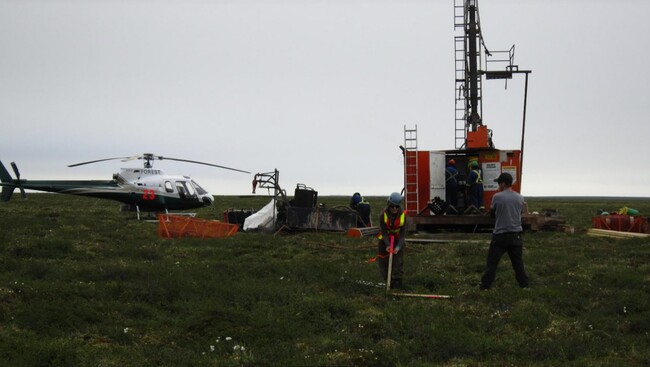Two companies on my list offered updates in recent sessions. This article includes some interesting details from notes taken during conversations with Apollo Silver’s CEO, Tom PereGoodoff, and Forum Energy Metal’s CEO, Rick Mazur. We’ll start with Apollo.
Apollo Silver (APGO.V) – (APGOF.OTC) – (6ZF0.FRA)
- 164.96 million shares outstanding
- $97.33M market cap based on its recent $0.59 close
On March 24, Apollo dropped a headline concerning its flagship Calico Silver Project located in San Bernardino County, California.
If you’re new to the Apollo story, Calico’s 166 million ounce resource base —a resource Apollo delivered via a February 9th press release—is ranked the 3rd largest silver resource in the U.S.
Calico, comprised of the Waterloo and Langtry deposits, hosts low-sulfidation epithermal-vein type and disseminated-style silver-barite mineralization. Both deposits are open at depth and along strike.
(click on the images below to magnify)

Before we get to the good stuff, I think it’s important to briefly touch on developments out of the K2 Gold camp and the challenges they’ve encountered operating in California.
To summarize K2’s troubles, on March 17, the Company announced the indefinite suspension of activities at their flagship Mojave Project located in Inyo County due to what they characterize as “an unprecedented Bureau of Land Management (BLM) decision.”
The skinny: K2 received notice from the BLM that an Environmental Impact Statement (EIS) would be required in advance of a proposed Phase 2 drill program.
According to this K2 press release, “This directly contradicts the fact that the BLM had already accepted, K2’s amended submission under the rules of a federal government’s Environmental Assessment (EA) Plan of Operation (PO) procedure as complete in March 2021. An EIS is a process usually reserved for mine development and construction, that would take in excess of at least one year, and require significant cost and resources to complete.”
Here’s the thing: There are 58 counties in California, and they all operate independently with their own set of standards and values where resource development is concerned.
Apollo’s Calico’s 166 million Ag ounce count is located in San Bernardino County.
San Bernardino County is NOT Inyo County.
One look at the map below, it’s clear that over half of Inyo County (shaded in light blue) is covered by Death Valley National Park (shaded in green). Sequoia National Park covers another good chunk. A territorial and politically-bound landscape such as this would make mine development a high-risk proposition anywhere in the free world, not just in California.

No such encroachments exist in San Bernardino County, where Apollo is located.
Further, San Bernardino County is a Tier 1 mining jurisdiction. There are more operating mines in San Bernardino County than in any other jurisdiction in the U.S. Due in large part to the number of mines operating in the region, California was ranked 4th in the U.S. for mineral production in 2020 (mining contributed US$13.6B to the state’s GDP).
According to the Surface Mining and Reclamation link on County’s website, “The County recognizes that the extraction of minerals is essential to the continued economic well-being of California and to the needs of society and that reclamation of mined lands is necessary to prevent or minimize adverse effects on the environment and to protect the public health and safety.”
Another big positive for Apollo’s 166M resource base is that Calico is located on private rather than public lands (public lands fall under the BLM at the Federal level). Apollo’s initial engagement is driven primarily at the county level.
A testament to the County’s support for resource development is the expeditious manner in which Apollo received its permits to launch an aggressive 15k drill campaign.
Obviously, as the project is pushed further along the development curve, the Company will also be dealing with officials at the state and federal levels regarding permits around wildlife, H20, etc.
It’s also important to note that the Waterloo component of the Calico resource base—116 million Ag ozs—has already been through the whole environmental impact process and was fully permitted to produce when ASARCO controlled the project back in the mid-1980s.
In a recent Highballer piece, I stated:
At ground level, Apollo has had positive meetings with the senior leadership of San Bernardino County. The district welcomes responsible resource development and has expressed interest in examining opportunities that support the Company’s development activities.
Moving along…
The March 24th headline:
Calico Silver Project 2022 Drill Program Update: Drill Rig Mobilization to Commence March 29, 2022
This 2022 Drill program represents one component of a multi-phase technical program designed to upgrade and expand the Company’s 166 million oz Inferred silver resource.
A Reverse Circulation (RC) drill rig is on its way to the property. Drilling with a single rig is expected to commence on April 4th.
The 2022 Calico Technical Program, as per the guts of this March 24th press release:
- The proposed drilling program comprises 15,000 meters (49,213 ft) of drilling using RC and diamond core drilling methods.
- Approximately 10,000 meters of RC drilling and 5,000 meters of diamond drilling are planned.
- Focus of the drilling program is to upgrade the confidence level of the MRE and to expand the deposits’ metal inventory through the following activities:
- Acquiring high-quality geotechnical, rock properties, geochemical and lithological information. Geotechnical, rock properties and lithological information will be acquired using both Optical Televiewer surveying and traditional logging methods.
- Expanding the metal inventory by:
- Confirming historic bonanza grade silver intercepts (+1,000 gram/tonne);
- Targeting areas that may increase the continuity of and expand high-grade silver mineralization identified in the MRE;
- Targeting shallow ounces by drilling untested Barstow Formation along strike and down dip; and
- Testing the gold-mineralized Barstow-Pickhandle lithologic contact (see new release dated January 11, 2022).
Updates regarding metallurgy and historic sample testing will be provided at a later date.
Apollo’s CEO, Tom Peregoodoff:
“With timing of the mobilization of the drill rig now confirmed, commencement of the first hole is imminent. The delay we have encountered was a direct result of issues related to the US/Canadian border blockade and broader supply chain issues that are all too familiar to most industries. Ultimately this delay should have no impact on the timing of the planned resource update and commencement of the Preliminary Economic Assessment in Q4. The 15,000 metre program we are announcing today is designed primarily to increase both the size and confidence in the resource at Calico. Testing of the recently identified gold mineralized horizon is also a key aspect of the program. Our initial drilling will focus on expanding the distribution of the known high-grade silver and results will be released as they become available.”
There are a few scenarios that could alter the 2022 drill plan.
During my discussion with CEO Peragoodoff, I learned that the majority of the drill spacings at Calico are at an Indicated level, but what’s missing is certain structural/geotechnical information required to boost those Inferred ounces conclusively into the higher confidence category. Drill core via the diamond drilling phase of the program will furnish that geotechnical data.
I also received a lesson in the efficacy of Optical Televiewer (OTV) technology—a tool the Company will deploy during this first phase of drilling.
Simply put, they’ll be running a camera down each RC drill hole. This crafty camera will deliver high-resolution structural images as it progresses down the borehole wall.
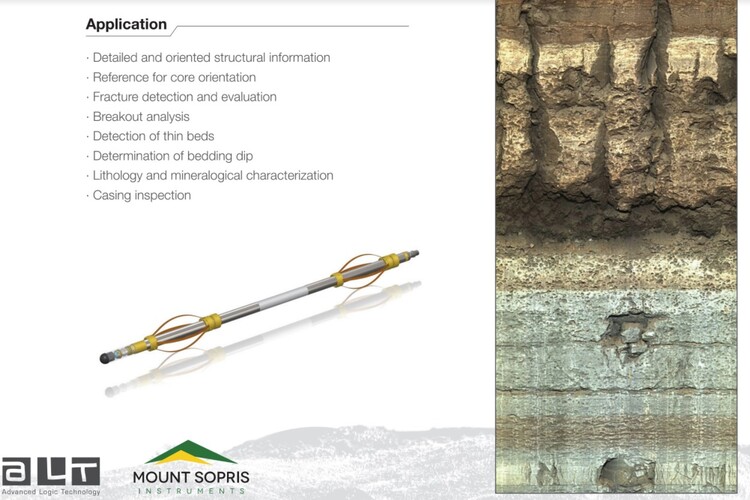
The OTV could potentially deliver all the geotechnical data required to push the Inferred material into the Indicated category, negating the need to mobilize a costly diamond drill rig.
If the OTV delivers what the Company needs to support the transition from Inferred to Indicated, the funds saved will go towards the mobilization of a second RC rig. Either way, this first phase campaign will see an acceleration via an additional rig at some point.
This OTV technology also conserves water consumption—a huge consideration in this drought-stricken part of the world.
Targeting higher grades
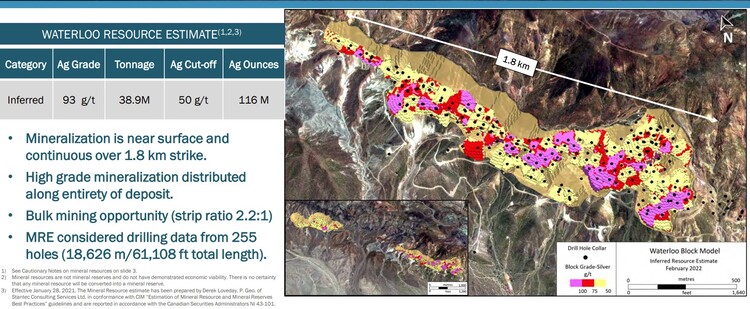
The initial holes in this 10k RC drill campaign will target the higher grade zones at Waterloo, where highlights from previous campaigns include the following shallow hits:
- DH-80 – 77.72 meters grading 329.7 g/t Ag from 28.96 meters (including 13.72 meters grading 955.7 g/t Ag from 65.53 meters;
- DH-163 – 41.15 meters grading 256.2 g/t Ag from surface;
- DH-42 – 51.82 meters grading 240.5 g/t Ag from 39.62 meters;
- W-43 – 45.72 meters grading 232.6 g/t Ag from 35.05 meters;
- W-0007 – 94 meters grading 198.1 g/t Ag from surface.
Expanding these higher-grade zones, if successful, could have a material impact on Waterloo’s overall grade for an updated resource calculation.
Shallow mineralization
Both Calico deposits—Langtry and Waterloo—boast near-surface oxide mineralization. The current resource base lies within 125 meters of surface. A number of the historical holes that comprise the current 166M ounce count ended in mineralization.
Where Waterloo is concerned, the Barstow formation south of the Calico Fault has never been tested with the drill bit. There’s ample opportunity to grow the deposit here.
There’s also potential for gold mineralization in Calico’s subsurface stratum, as highlighted in a January 11th press release.
Silver transitions to gold-dominated mineralization below the Waterloo resource base at the variably faulted lithologic contact between the Barstow formation sedimentary rocks and the Pickhandle formation volcaniclastics.
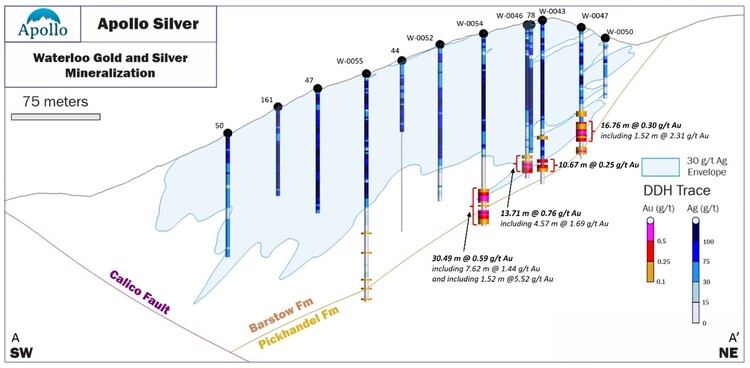
Testing this new gold horizon is a simple matter of extending the depth of the holes they plan to drill anyway.
Again, the OTV technology may serve as a proxy for a cylinder of drill core when sizing up these deeper holes (OTV technology knows no limits where depth is concerned).
The Company will also be drilling off areas containing shallow silver mineralization—areas not included in the maiden resource calculation due to broad drill hole spacings.
This stepout drilling will initially target an area to the south and downdip of the Waterloo resource base—note the open ground 1 kilometer to the southeast of the Burcham mine (map below).

An updated resource estimate, and a PEA, are expected by late Q4.
IMO, Apollo’s 166 million ozs are due for a substantial re-rating.
Forum Energy Metals (FMC.V) – (FDCFF.OTC)
Back in early February, Forum announced a strategic acquisition in the Thelon Basin, a vastly underexplored region in Nunavut. Many believe Thelon is where the Athabasca Basin was a half-century ago in terms of discovery and development.

Already having secured 44k hectares in the region, this early February acquisition captured an additional 53,402 hectares (solid green blocks, map below). This is ground that Cameco once held, and it’s on-trend with one of the largest undeveloped uranium deposits in the world—the 133 million pound Kiggavik uranium deposit held by Orano (66.2%), Denison (16.9%), and UEX (16.9%).

A March 22nd headline:
Forum announced several strategic hires in this press release: Rebecca Hunter (PhD., P.Geo), Denise Lockett, and Leon Davis.
Quoting Forum’s CEO, Rick Mazur, regarding these prudent engagements:
“Rebecca was instrumental in the exciting early days of the Tatiggaq and Qavvik discoveries and brings a wealth of geological knowledge to Forum. Leon lived and worked in Nunavut for eight years and understands the unique operating conditions of the project. Denise has been working with Nunavut regulators and communities for over twenty five years. Our Team is committed to the successful discovery of a Tier One uranium deposit next door to Orano’s Kiggavik Development Project.”
Shareholders also received a project update in this March 22nd press release.
“Forum has staked a further four claims bringing its total of new staking to 60,230 hectares (map below).”
The geological sleuths at Forum obviously have an appetite for this ground—ground they characterize as “pregnant” as mineralization appears pervasive throughout the property.

As per the guts of this March 22 press release, during the 2022 field season, Forum plans to:
- Review the 135 drill holes drilled by Cameco from 2008 to 2012 – drilling that led to the discovery of the Tatiggaq deposit, the Qavvik deposit, the Ayra showing, and three other targets identified by geophysics.
- Conduct airborne and ground geophysical surveys.
- Mobilize drills, camp and supplies to Baker Lake during the summer barge season in anticipation of a 10,000 meter drill program in 2023.
Tatiggaq
Tatiggaq lies roughly five kilometers to the west of Orano’s Andrew Lake deposit (see above map).
The Tatiggaq discovery consists of two zones—Main and West. Both average 30 meters in thickness at a relatively shallow depth—between 80 and 100 meters. The Main zone has a strike length of 60 meters. The West zone has a strike length of 80 meters.
Highlights from historical drilling include:
- TUR-026 – 1.0% U3O8 over 14.9 meters from 177.6 to 192.5 meters;
- TUR-040 – 0.92% U3O8 over 11.3 meters from 159.1 to 170.4 meters;
- TUR-042 – 2.69% U3O8 over 7.9 meters from 200.2 to 208.1 meters (including 24.8% U3O8 over 0.4 meters from 202.9 to 203.3 meters);
- TUR-052B – 0.43% U3O8 over 54.2 meters from 115.4 to 169.6 meters;
- TUR-056 – 0.93% U3O8 over 9 meters from 126 to 135 meters;
- TUR-058 – 1.17% U3O8 over 6.1 meters from 88.2 to 94.3 meters.
Solid hits.
Tatiggaq occurs within a large gravity anomaly measuring 800 meters in width by 1.5 kilometers in length. (map below).
Forum’s proposed 10,000k meter drill campaign will test for extensions of the Main and West zones. The Qavvik deposit and Ayra showing will also receive a proper probe with the drill bit.
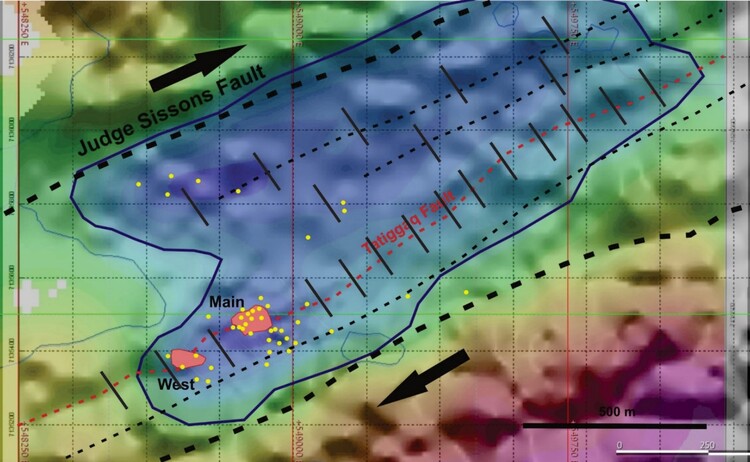
THELON BASIN- AN ATHABASCA BASIN ANALOGUE
There are many Proterozoic basins worldwide, but only two are economic; the Athabasca Basin in Saskatchewan, Canada and the McArthur Basin in the Northern Territory, Australia. The third promising Proterozoic basin for economic uranium deposits is the Thelon Basin in Nunavut, Canada, which thus far has three deposits that have been proposed for development (Figure 3). The Kiggavik Uranium Project is held 66.2% by Orano Canada, 16.9% by Denison Mines and 16.9% by UEX Corporation. Orano (formerly Areva) submitted a development proposal in 2008 for the 133 million pound Kiggavik Uranium Project at an average head grade of 0.46% U to produce 7.8 million pounds of uranium per year over a 17 year mine life from three deposits – the Kiggavik and Andrew Lake open pit deposits and the End underground deposit (Source: *Areva Resources Canada Inc., The Kiggavik Project, Project Proposal, November 2008 and Kiggavik Popular Summary, April, 2012 submission to the Nunavut Impact Review Board).
Orano conducted six years of engineering, environmental and community engagement studies from 2008 to 2014 and submitted a Final Environmental Impact Study to the Nunavut Impact Review Board (NIRB) on October 2, 2014. Despite meeting all conditions of the NIRB project review, Orano could not commit to a firm project start date, due to economic conditions in the uranium market at the time. NIRB recommended on May 8, 2015 that the project not proceed if a definitive development timetable could not be made. The project is currently on care and maintenance.
The journey to Thelon
For those of you wondering… 2023? Why can’t the Company just get on with it? Why can’t they mobilize a rig and kick things off now? Fair questions.
It’s all about logistics with this one. I can appreciate the hurdles here. My niche as a silviculture contractor was tackling remote, technically challenging projects along the coastal inlets of mainland B.C. Setting up a project required careful planning… and time.
The same applies here. From Montreal, an ocean barge loaded with cargo (camp, fuel, drill rigs, etc) will need to travel up the St. Lawrence River, around Newfoundland/Labrador, through the Hudson Strait between Baffin Island and Labrador, across Hudson Bay, and then up Chesterfield Inlet to Baker Lake.
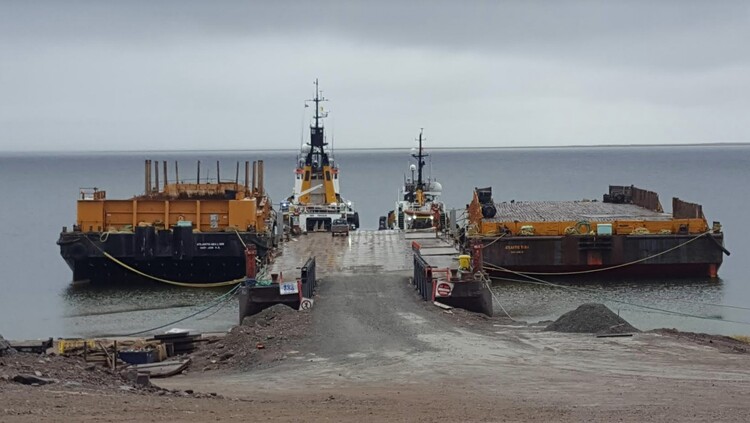
(barge season in this part of the world has a narrow window between June and September)
From Baker Lake, a Snowcat will drag the loads on sleds to the Thelon project during the spring of 2023.

Additionally, the Company points out that applications for permits are nearing completion and will be filed shortly. “Initial contact with the Baker Lake Elders has been made and Community Engagement will commence.”
So yeah, a lot dots need to be connected here before the drills can turn.
END
—Greg Nolan
Full disclosure: Forum is a Highballer client. I’m being compensated for the Apollo Silver content by Pacific Prime Communications Corp.
I hold shares in both companies featured in this article (I’m biased – please conduct your own due diligence).
